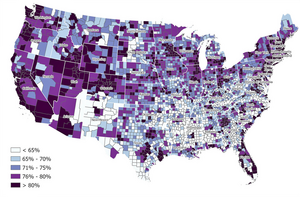Access to high-speed internet has become increasingly vital in providing adequate healthcare services, particularly for patients in socially vulnerable communities. However, many of these communities in rural America have limited broadband internet access, which hinders their ability to utilize online health services. A new study by the University of Cincinnati found disparities in access to digital technology that could widen the gap in access to health care, with many socially vulnerable communities facing barriers in accessing adequate health care and living in areas with fewer health care resources and limited broadband internet coverage. Telehealth has the potential to help vulnerable communities, but access to it is challenging for those who are not digitally literate or who do not own a smartphone or computer. The United States needs to create policies and programs that increase access to telehealth services in these communities to ensure equal access to health care.
Access to high-speed internet has become crucial in providing adequate health care, especially for patients who reside in socially vulnerable communities in the United States. However, many of these communities, particularly in rural America, have limited broadband internet access, which hinders their ability to utilize online health services.
A new study by the University of Cincinnati has revealed that disparities in access to digital technology could widen the gap in access to health care. According to the study, many socially vulnerable communities face barriers in accessing adequate health care and live in areas with fewer health care resources and limited broadband internet coverage.
UC researchers presented their findings at the American Association of Geographers’ annual conference in Denver, emphasizing the importance of high-speed internet access and digital literacy in using telemedicine and online health services. The researchers conducted county-level data visualization and spatial analyses to assess the geospatial association between digital disparities and health care in the contiguous United States.
The study’s author, UC epidemiologist Diego Cuadros, stated that patients need access to high-speed internet, computers, or smartphones and familiarity with technology to use these systems comfortably to take advantage of the growing shift to telemedicine and online health services.
In response to this growing issue, the Biden administration announced it would invest $73 million in outreach grants to provide affordable high-speed internet to more Americans, specifically addressing the gap in access to health care created during the COVID-19 pandemic when providers began offering more health care services online.
Cuadros warns that the digital divide is only going to get bigger, especially since future healthcare will become more reliant on these technologies. Thus, it is crucial to bridge the gap in access to high-speed internet and digital technology to provide equal health care access to all Americans.
Diego Cuadros, the author of the study conducted by the University of Cincinnati, believes that the pandemic has accelerated the adoption of technologies that will become an integral part of daily life, including health care services. The United States is a telecommunications leader globally, but its per capita wireless coverage doesn’t even make it to the top 20 nations, according to a 2023 Statista survey. This is mainly due to the large size of the country.
Claudia Moreno, the study’s collaborator, points out that there is a strong correlation between broadband access and the socioeconomic and health care vulnerability of certain regions. She suggests that broadband coverage can act as an institutionalized inequity that needs to be addressed to help vulnerable communities.
Moreno further explains that although the pandemic served as a catalyst for people to adopt new ways of doing things, not everyone has made the same digital transition. She highlights that telehealth has the potential to help vulnerable communities, but access to it is challenging for those who are not digitally literate or who do not own a smartphone or computer. Therefore, the country needs to create policies and programs that increase access to telehealth services in these communities.
Don’t miss interesting posts on Famousbio

